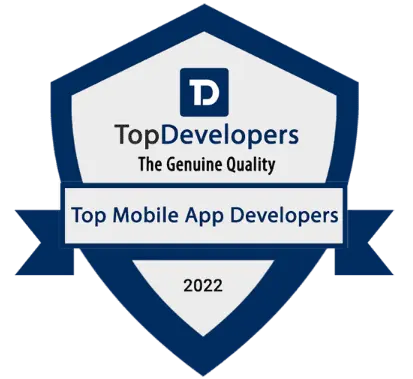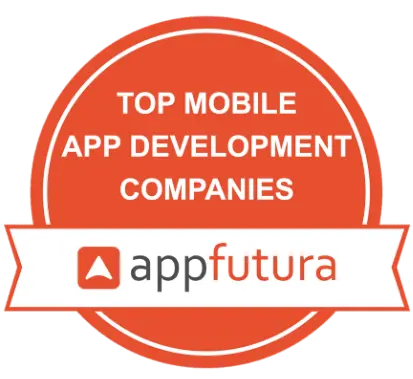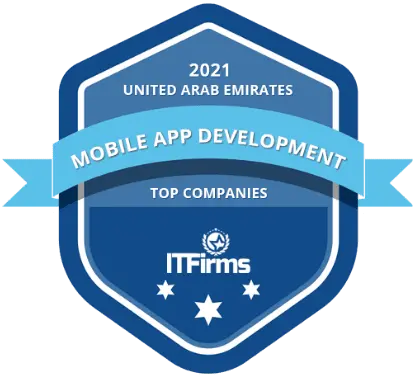Have you ever been amazed by the capabilities of ChatGPT? A tool that can write an email, debug code, and brainstorm ideas in seconds. It’s no surprise that numerous businesses are now wondering how to make a Chatbot Like ChatGPT for their own operations.
The latest Gartner, Inc. forecast shows that IT spending will reach 5.61 trillion in 2025, up 9.8% over 2024. That is why companies are pouring funds into the AI chatbot development, as chatbots are not only about customer service. Their assistance can be used to automate business, cut costs, and create unique experiences, which leads to loyalty.
And now you might be wondering, do only tech giants build an AI chatbot like ChatGPT? Nevertheless, in the current state of development, anyone, including startups, can develop their own chatbot apps.
You can create your own AI chatbot, designed to fit your specific business, and it takes questions on your behalf, 24/7. That is more clever, quicker, and easier for the customer.
And, now that we have all the prerequisites, let us jump into this Chatbot Development Guide. This is where you will learn how to create a chatbot like ChatGPT, the technologies, the cost of creating an AI chatbot like ChatGPT, and how to overcome the challenges.
We will also give you a few tips that will help you reduce the cost of developing the AI chatbot without reducing the quality. So, let’s get going!
Why Build an AI Chatbot Like ChatGPT?
Simply, it’s good to have an assistant who never sleeps, never forgets, and has the ability to respond to hundreds of customer inquiries immediately. It’s the benefits of an AI chatbot like ChatGPT that businesses will receive when they invest in chatbot app development.
The time has changed, and the old-fashioned bots, which merely respond to predefined instructions, ChatGPT-like chatbots that offer conversational intelligence.
They can read context, learn through interactions, strictly follow the guidelines, and adjust to customer preferences to create more personalized and natural experiences while reducing costs. And the numbers prove their impact.
However, AI chatbots offer:
1. Round-the-clock service
Customers do not like waiting. By investing in AI chatbot development, you may provide 24/7 service in your business operations.
2. Personalization at scale.
These chatbots look at how people interact and provide tailored responses. One example is a medical AI chatbot that can give health advice, and a shopping assistant that can recommend purchases based on a review of past purchases.
3. Cost Savings
AI chatbots will help businesses save over 11 billion dollars annually in customer service costs by 2025. That is to say that you can serve more customers without a larger human workforce.
4. Enhanced Customer Experience
Customers feel like they are being listened to through natural conversations: something simple bots cannot offer.
Lastly, chatbots are not only for customer support, but they are transforming entire business operations. Meanwhile, most of the companies are even using them to replace some of their repetitive positions.
How Businesses Use AI Chatbots like ChatGPT?
Let’s explore the table and understand how different businesses are using AI Chatbots:
| Use Case | Percentage of Businesses |
|---|---|
| Sales | 41% |
| Support | 37% |
| Marketing | 17% |
| Other | 5% |
Sales Chatbots
Out of the 41 percent of companies that sell with the AI chatbot’s assistance, the outcomes are impressive:
- The sales increased by an average of 67 percent.
- Chatbots make a quarter of all sales.
- Chatbots are said to help leaders close deals by 35 percent.
Sales chatbots are skilled at collecting data, qualifying leads, demos, and communicating with people visiting a site. Modern consumers demand answers quickly and at a personal level, and sales conversations are shifting towards live chat, which is also an AI-powered feature.
Support Chatbots
Customer support is another important domain where chatbots perform well. Approximately 37 percent of firms use them to handle customer requests. Why? Their reaction is nearly 3 times faster than human operators.
- Chatbots have made complaint resolution 90 percent faster.
- Customer satisfaction rating rose by 24 percent.
- More than three out of four leaders said that call volume increased after implementing AI chatbots.
Large volumes of chats are processed by support bots in seconds, so that the human teams can work on complex cases, with no customers waiting.
Core Technologies Behind ChatGPT-Like Chatbots
So, how does ChatGPT interpret what you input and generate human-like responses? The answer is a combination of AI technologies. Let’s break it down.
ChatGPT is based on NLP and the transformer architecture (the T in GPT). The transformers divide language into smaller units, extract meaning between words, and determine the next word. This is what makes the answers sound natural rather than machine.
But NLP alone isn’t enough. Machine Learning (ML) and Deep Learning (DL) come to the rescue there. These systems teach the model to read huge quantities of text in order to understand patterns, context, and intent in your words.
All responses are generated on the spot and are influenced by your specific query. Combine that with Reinforcement Learning with Human Feedback (RLHF), and you have a model that learns by error, becomes more accurate, and more conversational as time goes on.
Take a look:
| Technology | What It Does | Why It Matters |
|---|---|---|
| Natural Language Processing (NLP) | Processes and interprets human language | Helps ChatGPT interpret what you say. |
| Machine Learning (ML) | Learns from massive datasets | Improves accuracy and adaptability |
| Deep Learning (DL) | Recognizes complex patterns in text | Provides richness to comprehension and response generation. |
| Transformer Architecture | Breaks down and analyzes relationships between words | Decomposes and dissects word connections. |
| Generative AI | Creates new text in real time | Make sure that answers are not pre-written, but fresh. |
| Reinforcement Learning with Human Feedback (RLHF) | Filters responses according to human input. | Makes replies more natural and human-like |
How to Develop an AI chatbot like ChatGPT?
The process of creating a Chatbot like ChatGPT seems complex, but when it is divided into steps, the process becomes easier to understand. Let’s just dive into the AI chatbot development step-by-step guide.
1. Set the Foundation
All great chatbots begin with the discovery phase, setting the foundation. Start by determining the target audience, what issues the chatbot will address, and how it can create an impact.
Think of this stage as your research sprint. Collect data, research customer needs, and identify the niche datasets that your chatbot will need. For example, building an AI chatbot in healthcare requires HIPAA-compliant data, whereas a fintech chatbot will have to be trained on financial laws and flows.
2. Prototype (Optional, but useful in some cases)
Usually, AI applications have the advantage of prototypes that can be clicked on to allow the user to test-drive the design before coding starts.
However, the value of chatbots is restricted. The majority of chat interfaces already resemble each other: there are text bubbles, a typing field, and perhaps a few quick action buttons.
So, when does prototyping make sense?
When your chatbot requires a new experience that cannot be demonstrated with the help of standard chat layouts, otherwise, you may skip it and save time.
3. Proof of Concept
Heard about the MVP, right? For testing the core ideas with a minimal set of features and the proof of concept with the app’s core features.
So, rather than creating an entire MVP immediately, create a proof of concept (PoC) first. This is a stripped-down version of your bot that will verify two things:
- Can the chatbot provide relevant, context-aware answers?
- Do the users like and use it?
For example:
A clinic may open a PoC that can answer common questions, provide contact information, and schedule appointments. In case it is useful, you can scale it to a full AI assistant in the future. The PoC makes certain that you are not spending months developing a bot that no one will be willing to use.
4. Design phase
In the case of chatbot UI, less is more. The majority of users desire a clean, user-friendly chat box; therefore do not think a lot about it.
Only invest additional design effort when your bot contains interactive add-ons such as:
- File uploads
- Appointment calendars
- Rich media cards
Otherwise, the normal flow of chat is sufficient.
5. Coding phase
Since OpenAI provides access to ChatGPT, you can now easily build your own chatbot. Choose whether to use ChatGPT APIs or to train your own GPT model.
Install data pipelines to continue training your chatbot with relevant data. And select a cross-platform solution such as React Native or Flutter. You probably want to deploy the chatbot to the web, iOS, and Android.
Best practices while coding:
- Work in agile sprints for faster iteration.
- Use transparent task management (e.g., ClickUp, Jira).
- Establish DevOps early enough to avoid making deployment and scaling a nightmare.
6. Testing
Testing is the most crucial aspect of development stages; ideally, it should be done before each new build. So, testing your chatbot thoroughly in each phase will help you overcome challenges.
Because users will attempt to test your chatbot, pose prompting questions, or even take it off the road. That’s why you need:
- Tools of moderation to prevent harmful outputs.
- Real user stress tests to identify unforeseen behavior.
- Ongoing feedback mechanisms to hone responses.
This phase will make your bot feel safe, reliable, and trusted.
7. Release & Maintenance
Launching a chatbot is easy when you put in your efforts and plan everything from the beginning. The good news for maintenance is that, if you use ChatGPT APIs, the majority of model improvements will be done by OpenAI under the hood. You’ll mainly focus on:
- UX/UI improvements
- Performance monitoring tools such as Sentry.
- Correcting bugs and adding features as required by users.
And, another aspect not to be forgotten is marketing, launch campaigns, demos, and onboarding guides to ensure that people actually use your bot.
Estimated Cost of Developing a ChatGPT-like AI Chatbot
And now the big question is, how much will it cost to create an AI chatbot like ChatGPT? Well, the answer is not as simple as it seems. Since the cost to build an AI chatbot depends on several factors. Depending on the level of sophistication that you require your chatbot to be, it will cost you between $50,000 and $300,000 or more.
We can take a closer look at the major factors that influence the budget:
1. Development
It is costly to create something completely new, whereas ready-to-use models (such as GPT APIs) may be cheaper and quicker.
2. Functionalities & Features
Simple Q&A bots are less expensive than chatbots with advanced NLP, voice support, or multi-language support.
3. Technology Stack
AI systems, cloud computing, and security layers can also be accumulated.
4. Team Composition
The cost of hiring AI engineers, UI/UX designers, and QA testers is higher than that of outsourcing to an AI chatbot development company.
Let’s look at the table for the approximate cost breakdown.
| Factor | Estimated cost range | What it includes |
|---|---|---|
| Development (MVP) | $30,000 – $50,000 | Basic chatbot with limited NLP features. |
| Advanced AI Integration | $80,000 – $150,000 | Includes deep learning, personalization, and real-time conversation flow. |
| Voice & Multilingual Support | $20,000 – $40,000 | add-on Enhances usability and global reach. |
| Cloud Hosting & APIs | $1,000 – $5,000/month | Depends on traffic and usage. |
| Maintenance & Updates | $5,000-20,000/year | Includes bug fixes, retraining, and scaling. |
Bonus Tip: When you are just starting out, don’t aim for a ChatGPT-level chatbot right away. First, build an AI chatbot with POC and validate your idea, and then scale up as the demand grows.
Challenges of Building a ChatGPT-Like Chatbot
It is not a smooth sailing process to make a ChatGPT-like chatbot. It is a complex task that has some challenges. You might be thinking that the biggest challenge is the code itself, but it’s more than you think.
The real issues tend to be about data, ethics, and long-term maintenance. The following are some of the major hurdles that you will encounter in the process of creating an AI chatbot like ChatGPT. Let’s get going.
1. The Need for High-Quality Data
The quality of AI chatbots is determined by what they have been trained to use. Your chatbot is not going to work the way you want it to, unless you have a huge, clean, and relevant dataset. This is not a question of quantity, but quality.
This data may be tedious and time-consuming to source and prepare. When the information is skewed or not comprehensive, the chatbots will respond accordingly.
Solution: Prevent this by investing in an efficient data collection and cleaning process. Use both public and proprietary data and practice a system of constant data refinement.
2. Uncontrolled or Unresponsive Responses.
Have you ever had an AI chatbot hallucinate or give a weird, out-of-context reply?
This is a common challenge. Large language models are sometimes capable of producing responses that are both factually wrong and inappropriate. It is sort of a wild card, and in professional use, it is a no-no.
Solution: The answer lies in fine-tuning and installing effective safety filters. To achieve a stable and dependable user experience, you may also require a human-in-the-loop system to audit and fix responses that are problematic responses.
3. Data Privacy and Security Concerns
This is the biggest challenge, especially when you’re dealing with customer details. It can be a serious risk to train a chatbot on sensitive data.
Reports show that 73 percent of U.S. consumers are concerned with the privacy of their personal information when communicating with chatbots.
Solution: Always prioritize data minimization and end-to-end encryption. Gather as little information as you must and keep it safe and secure. Disclose your data practices to users.
4. High Computing Costs
The computational power required to train a large language model is huge. We are referring to the big usage of powerful GPUs, which can result in huge cloud service invoices. The model may also be costly to run and maintain once it is deployed.
Solution: This can be alleviated by training a pre-trained model and fine-tuning it instead of training a model. Your model can also be optimized to be smaller and less resource-intensive.
Future of ChatGPT-Like Chatbots in 2025 and Beyond
Chatbots have evolved significantly in recent years and are no longer mere FAQ responders but sophisticated conversational partners. The future is even more promising, as smarter, more intuitive, and human-like interactions would be the new norm.
1. Smarter Virtual Assistants with Emotional Intelligence
AI-driven assistants can now be used to do more than just book tickets or respond to simple questions. They can learn to read tones, feelings, and even emotions in a conversation.
It’s good to have a digital assistant feel your frustration with your reaction and actively propose a solution, such as suggesting a nearby fitness center or rescheduling an appointment to alleviate your workload.
Such a more in-depth emotional intelligence might alter the way individuals work with digital systems both at home and at work.
2. Natural Language Processing Gets Even Better
The next large change will be due to further developments in Natural Language Processing (NLP). Chatbots of the future will have the ability to read between the lines, slang, and even hints in a conversation, and their responses will be similar to those of a human agent.
3. A Bigger Role in Online Shopping and Customer Support
The adoption of eCommerce chatbots in online stores has already begun to change the shopping experience, but by the year 2025, it will have become entirely seamless.
Through generative AI-driven personalization, these bots will suggest products, cross-sell related products, and direct a customer through the entire purchase process.
In addition to e-commerce, AI chatbots are also going to be used by customer service teams, but not as substitutes; rather, AI chatbots will be used as effective collaborators to deal with repetitive requests, while human agents will be involved in more challenging matters.
4. Payments Through Conversations
Another field where chatbots will shine is digital payments. Although AI chatbots in banking are creating their impact, by 2025, making payments via a chat window will probably be the default. Conversational payments will save time and friction, whether it is splitting a restaurant bill, sending money to a bank, or buying a product online.
How to Reduce the Cost of Developing an App Like ChatGPT?
The development of a chatbot like ChatGPT can be resource-intensive, yet with the proper strategies, you can save considerable costs without sacrificing quality. Some of the ways to do that practically are:
1. Start with a Minimum Viable Product (MVP)
As we have discussed above, rather than creating a full-fledged chatbot immediately, start with an MVP that includes the basic functionality of a chatbot.
Such as natural language processing, response generation, and a basic interface. This will assist you in testing your concept and getting early users with minimal initial expenses.
2. Building a Unimodal Dataset
Although multimodal chatbots (text, audio, video) are becoming more popular, they are also more expensive to develop and train.
A unimodal data set that deals only with text-based interactions would be quite sufficient in terms of the main objective and much more cost-effective. Most of the successful AI chatbots began unimodal and then expanded over time as the demand increased.
3. Use Pre-Trained Models
It is costly and time-intensive to train an AI model. Instead, use pre-trained language models like GPT-based APIs or open-source frameworks and fine-tune them for your niche. This type of approach saves much time in development and infrastructure expenditure.
4. Adopt Cloud Infrastructure Smartly
Rather than investing a lot of money in on-premise servers, look at scalable cloud services, AWS, Azure, and GCP. Cloud providers enable you to pay as you go, and you increase or decrease the resources according to demand. This keeps the operating costs in check.
5. Outsource Specialized Tasks
It can be expensive to hire in-house AI engineers, data scientists, and UI/UX experts. It can be less expensive to collaborate with a well-established AI app development company or outsource specific services and still access professional expertise.
Why choose The Ninehertz?
It is just as important to know when to introduce an AI chatbot into your business as it is to get the right development partner.
Many businesses do not implement this change until their customer support team is so overloaded with repetitive calls. Or when the company expands to such a degree that providing customers with consistent experiences becomes more difficult.
That is precisely when The NineHertz comes in.
With 250+ skilled developers and 12+ years of experience in creating digital solutions, we have the expertise to develop the best next-gen solution at The NineHertz.
We are strong in our capability to comprehend real-life business problems and develop AI-based solutions that are perfectly aligned with user requirements and organizational objectives.
So, when is the right time to integrate an AI chatbot?
We not only build AI chatbots, but we also assist you with finding the right time to incorporate them into your workflow. Likewise, when your company is growing at a fast pace, our chatbot products will make sure that the number of customers increases without straining your workforce.
Here is why you should choose our artificial intelligence development services :
- Years of Expertise – Years of experience enable us to streamline the development process, which will enable you to save on costs without compromising quality.
- Free consultation– We help businesses develop their version of the AI app with expert advice, even before the developer starts working on it.
- Scalable solutions – All AI applications that we develop are structured to support growth, which means that they will perform smoothly as your user base increases.
- End-to-end support – From the beginning to long-term maintenance, we offer 24/7 support to ensure your app is safe, efficient, and future-proof.
- Data security first – And with tight Non-Disclosure Agreements (NDAs), and safe practices, your project data is perfectly secure and confidential.
Conclusion
From above, it’s now clear that the adoption of AI chatbots is growing at a fast pace in every sector. The second wave of innovation will not only make them more efficient but also more understanding, intelligent, and empathetic.
As Sundar Pichai has once remarked, one of the deepest things that we as humanity are doing is artificial intelligence. That quote sounds particularly accurate when we consider the digital assistants of the future, not merely responding to queries, but knowing us.
To businesses, AI chatbot development translates to huge opportunities. A strategic, early adoption of AI chatbots will enable greater efficiency, lower costs, and improved customer interaction.
However, it is not only about the implementation of AI, but also about the selection of a capable development partner that knows not only the technology, but also the business requirements.
In the future, AI chatbots are going to transform our understanding of customer service and online communication. They are not just tools, but they are becoming smart partners that can foresee, adapt, and evolve with users.
Simply, the future of chatbots is the future of digital connection itself, as it is closing the gap between humans and machines on more significant levels.
Frequently Asked Questions (FAQs)
What is the time required to create an AI chatbot?
The timeframe of an AI chatbot development will be determined by its complexity, functionality, and degree of customization. Another rule-based chatbot can be developed within 34 weeks, whereas an advanced AI-powered chatbot, such as a chatbot using natural language processing (NLP) or a large language model (LLM), can be developed in 36 weeks.
Other factors, such as incorporation with third-party systems, multi-language, and personalization, also influence the timeline. A skilled development team can help to eliminate most delays and accelerate deployment.
What is the cost of creating a custom chatbot like ChatGPT?
The development cost of a chatbot like ChatGPT depends on the requirements. The simplest AI chatbot can be as cheap as $10,000 to $50,000, and a highly complex, enterprise-level solution with advanced AI models, integrations, and scalability would easily exceed $100,000.
- Continued costs like cloud hosting, API usage, retraining, and maintenance are also to be considered.
- Cost optimization is possible by launching a minimum viable product (MVP) and adding features as time progresses.
How do I know whether my business really needs an AI chatbot?
AI chatbots are essential in fields such as e-commerce, banking, healthcare, and travel, where quick answers are essential. Provided that your customer experience objectives are consistent with accelerated response, reduced expenses, and interaction, an AI chatbot can provide a high ROI.
You must think of using an AI chatbot when your business:
- Handles large volumes of repetitive customer queries.
- Must deliver 24/7 customer service without adding to the staff.
- Desires to tailor user experiences with data insights.
What is the frequency of re-training or updating my chatbot?
AI chatbots need to be retrained periodically to be effective. In the case of most businesses, quarterly updates are advisable to provide refinement to responses and answer emerging customer queries.
What are the pitfalls to avoid when releasing your first AI chatbot?
Businesses tend to make some mistakes while releasing their first AI chatbot, these include:
- Unnecessarily complicating the initial version, try to keep it simple and add complexity over time.
- Lack of attention to user experience, the chatbot should be conversational, not robot-like.
- Absence of training data. When bots are poorly trained, it frustrates the user and harms trust.
- There should always be an option for the user to communicate with a human agent.
- You cannot measure performance or optimize response without monitoring the interactions.
Great Together!

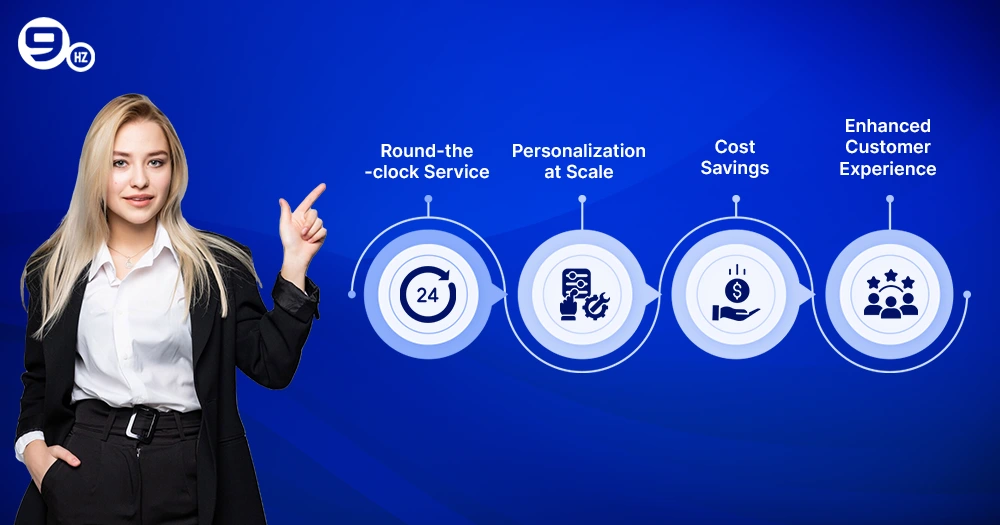
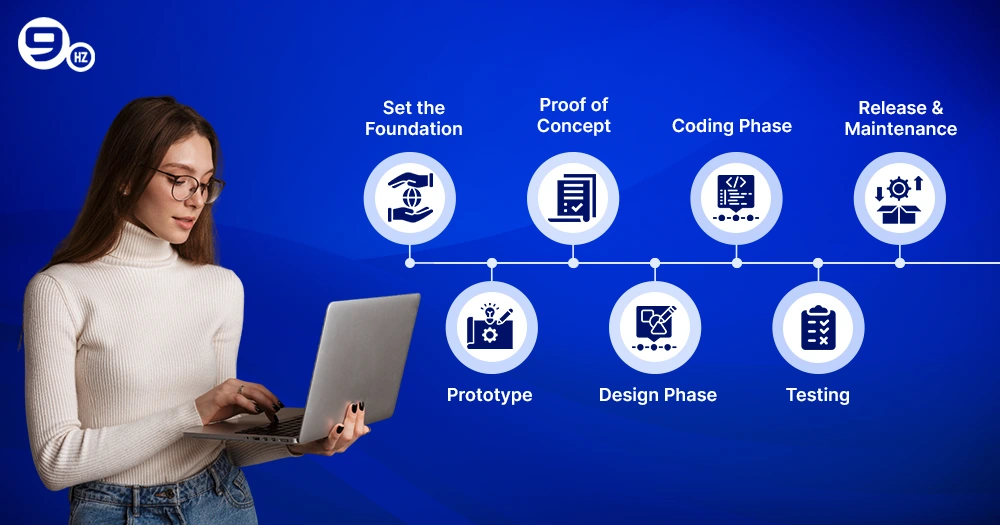
![How to Make an iPhone Game? [2026 Guide]](https://theninehertz.com/wp-content/uploads/2022/12/How-to-Make-an-iPhone-Game.png)


